Girls und Panzer: Deconstructing Gender with Tank Combat
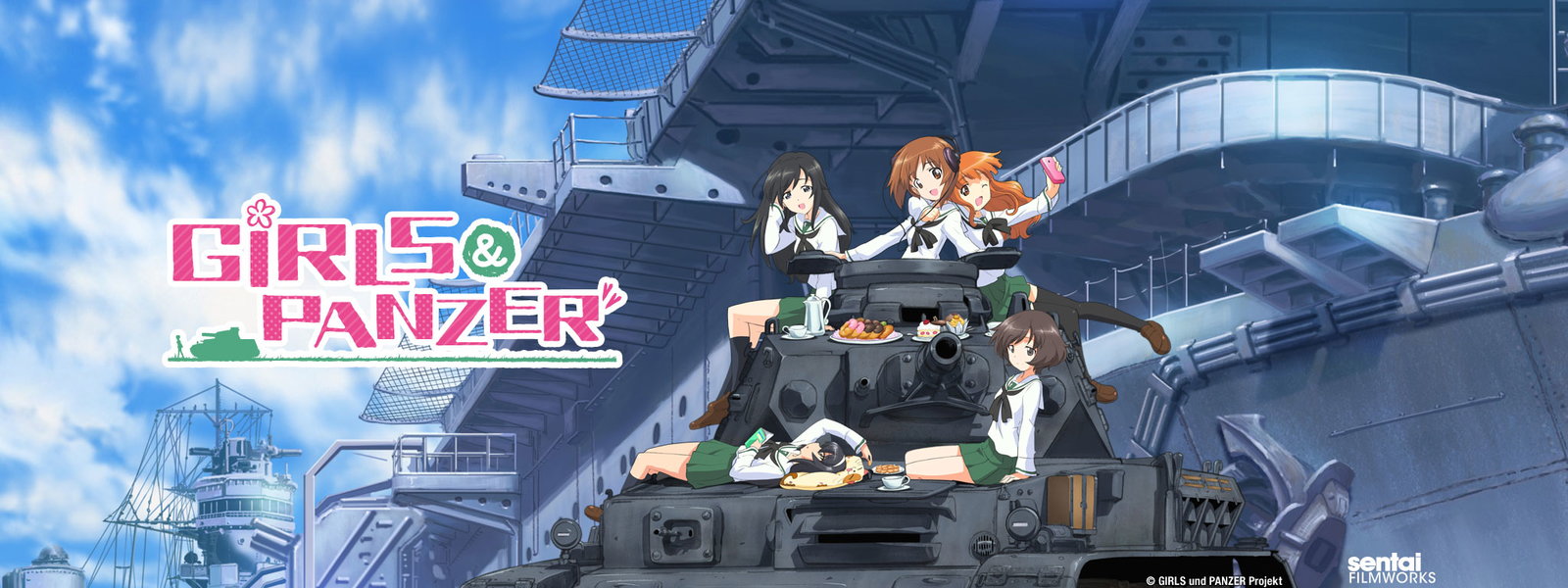
It has become increasingly common for female characters to take leading roles in mainstream popular culture. Not only is female representation improving, it is also becoming less and less unusual to see female characters perform outside of their traditional gender roles in popular culture. The success of the 2015 action-film Mad Max: Fury Road, which features a female soldier as the main protagonist, has shown us how much we are changing in our attitudes towards strong women in stories. This change is not limited to film and television however; Japanese animation frequently challenges and toys with the concept of gender as well. Numerous animated series and films from Japan feature strong female characters, strong female protagonists, and even predominantly female casts. Many take the step further, by tearing down conventional notions of gender at a fundamental level. The 2012 anime Girls und Panzer is one such series that attempts to do this by exploring alternative ways to view gender role and gender performance, and can even be read as work of deconstruction.
Redefining Womanhood
Girls und Panzer or Garupan for short is set in a universe in which tank warfare is widely practiced as a sport, known as “senshadō” or “way of the tank.” An important quality of the sport is that it’s practiced exclusively by women, usually high school or college aged. The series’ take on gender is particularly noteworthy in how attempts are made within its universe to redefine notions of femininity. The role that senshadō seems to play in shaping women in this society is made evident when the sport is first being introduced to the protagonists. In a presentation to the promote sport to the school, senshadō is advertised as a martial art that enhances a woman’s femininity by making her “become hot and tough as steel, as robust and lovely as caterpillar tracks, and as passionate and accurate as a cannon (Girls und Panzer).” It adds that those who take up senshadō will “without a doubt become a great wife, a great mother, a great career woman, and a woman who will appeal to many men (Girls und Panzer).” These assertions are particularly interesting in that the characteristics of tank combat, an activity that wouldn’t be perceived as feminine in the real world, are in a way forcefully associated with womanhood. Through this reassignment of ideals, it is demonstrated here that concept of gender can be largely rooted in social construction rather than biological division.
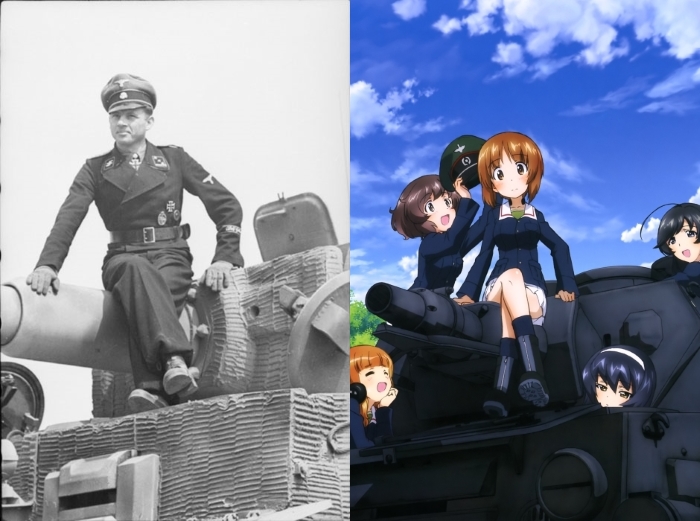
In regards to the character cast, the makeup of characters is overwhelmingly female and female-dominated. This largely stems from the fact that senshadō is practiced exclusively by women in this universe. Boys of comparable age to the main characters do not appear in the series and the few men who do are usually family members, a small number of elderly men, or male bystanders. This gender makeup may not necessarily allude to a female-dominated society in the universe. However, considering how notions of femininity seem to differ significantly in this universe from that of the real world, one can infer that gender roles are far from traditional here. In any case, filling the cast with women and making senshadō a female-only sport works against the norm of male-driven storytelling and could very well serve to simulate what a female-dominated society could look like.
What is also telling about the cast, in addition to the shortage of men, is the way the men themselves are portrayed in the series. The house servant Shinzaburo, although initially introduced as a handsome and polite retainer of the Isuzu household, is quickly shown to be subservient in character and highly emotional, bursting into tears at numerous points in the series. The father of the group’s tank loader Yukari Akiyama, the only other male worth noting, is significant in how he behaves in comparison to his wife. In his single appearance, he is shown to be overexcited, anxious, and comedically awkward. Yukari’s mother on the other hand is shown to be much more level-headed and is given a more driving personality than her husband.
Flowers or Flames?
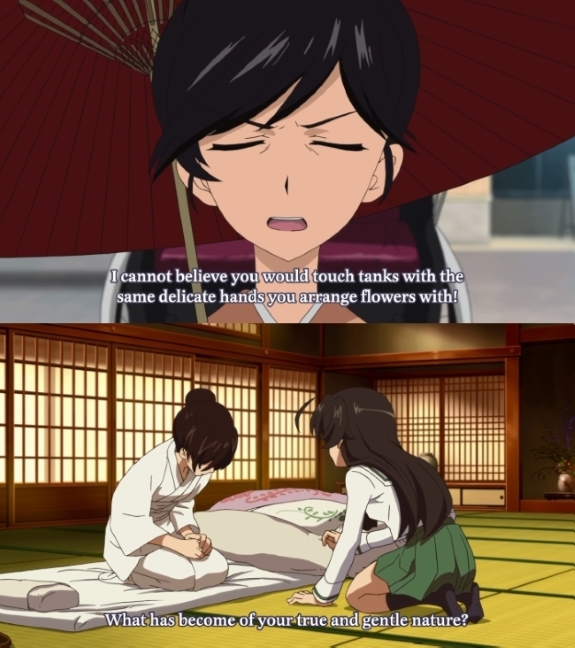
Although the rules of femininity are modified to accommodate senshadō, traditional norms still remain prevalent in this society. This is made evident in the subplot involving the group’s tank gunner Hana Isuzu and her mother. Near the beginning of the story, Hana acts against her family’s traditions by quitting flower arrangement to take up senshadō. Believing the sport is not suit a “delicate and gentle” woman, Hana’s mother disowns her and has her banished from their household. Later on in the story, she reveals that she had not given up flower arranging entirely, despite fully committing to senshadō, and goes as far as to arrange a piece inspired by the sport. Hana’s mother reconciles with her upon realizing that senshadō did not change her for the worse but instead makes her an even better artist.
Perhaps the intent of including this subplot was to explore the question of whether one can participate in supposedly unfeminine activities without also giving up her womanhood. The result of this dispute may imply that it is indeed so. Having a background in flower arranging did not result in Hana being any less effective in tank gunnery, nor did taking up senshadō cause her to become any less of a woman to her mother in the end. Questions of femininity aside, this subplot may have conveyed an even more valuable message for the viewer: What mattered the most was not Hana’s actual decision but rather the fact that she made the decision for herself, without any concern for societal expectations.
Not Just A Weapon
Phallic symbolism may also have a role in the deconstruction of gender in Garupan. The phallus, which is any object that resembles an erect penis, is notable in that it represents both tangible and psychological power that would otherwise be exclusive to men. As women do not possess male genitalia, the possession of a phallic object is sometimes necessary to demonstrate a degree of parity. Not unlike the magic wands used in the shōjo manga Sailor Moon, the tank guns depicted in the series can be interpreted as phallic representations of power. They are not only significant in a visual sense, but are also significant in their ability to put individuals on an equal footing. Whether the user behind the weapon is male or female, strong or weak, large or small, its capability does not diminish. Another interesting detail to note is how the tank operated by the protagonists is upgraded with larger guns throughout the story. At the beginning of the story, it is armed with a short-barreled howitzer. However, by the story’s conclusion, it is armed with a longer and more powerful anti-tank gun. A connection can be drawn between this progression of armament and the growth of the protagonists as great senshadō practitioners. As the team gains proficiency in their craft and continue to win battle after battle, their symbolic phallus grows larger in size.
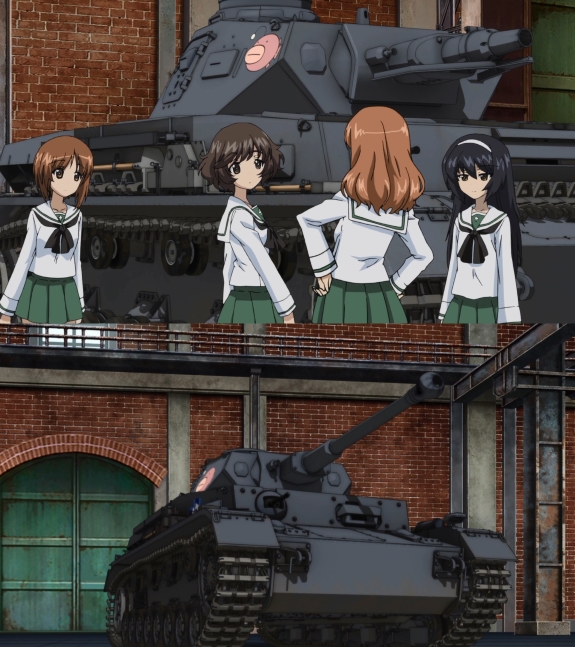
Overcoming the Male Gaze
One can justifiably dismiss the series as a product of male sexual and aggressive desire, with no purpose other than to indulge its audience with attractive young women and military hardware. When it comes to Japanese animation, the use of a largely female cast is by no means revolutionary, nor does it necessarily imply a feminist or egalitarian message. However, it is not entirely unreasonable to read Garupan from a more sociopolitical angle, and interpret the series as a satire on gender norms or as a playful expression of female empowerment. Moving forward, viewers might be led to ask questions on what even constitutes femininity, on where one would draw the line between masculine and feminine, and on ways power can be represented with respects to gender.
Taking historical events into consideration, using tanks to empower women might not be such an absurd premise in reality. In addition to serving as snipers, machine gunners, and anti-aircraft gunners, women of the Soviet Union also served in tank crews during the Second World War. Female tankers like Aleksandra Samusenko and Mariya Oktyabrskaya, who both died heroically in battle, demonstrated that giving up one’s womanhood is not necessary to “become hot and tough as steel, as robust and lovely as caterpillar tracks, and as passionate and accurate as a cannon.” In a similar fashion, the characters of Girls und Panzer were able to perform what was historically a man’s job and fight without giving up their own identities.
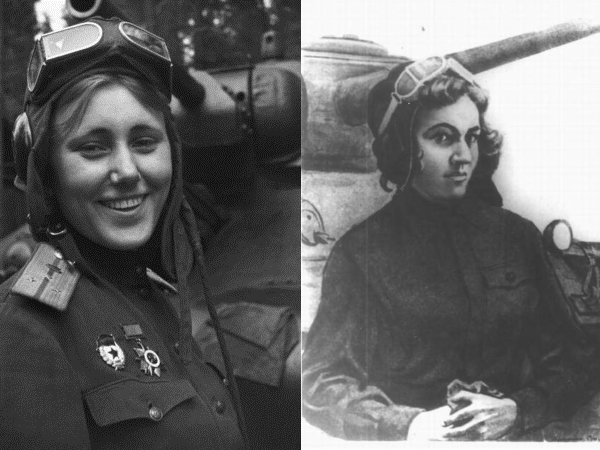
What do you think? Leave a comment.




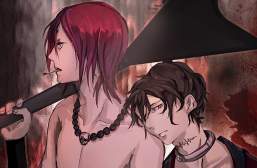



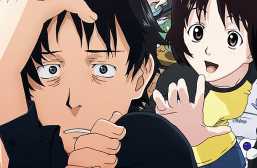
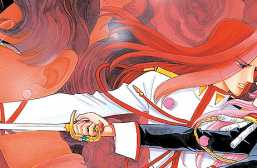

I’m a huge fan. It started off a little slow for me, but by episode 4, it definitely picked up and ended up turning into one of my favorite anime. It’s sitting in my personal top 10 anime.
GuP is not about having a unique story, or about a cast of highly dynamic characters with great depth and development. It’s about having well thought out and executed tank battles in a bizarre high school girl setting, and it pulled that off better than anyone could have possibly expected.
Nice read. In the spirit of discussion, what do you feel that a continuation would need to do in order to be successful? For instance, would next season need to do things differently, or is Girls und Panzer one of those things where variations on a tried-and-true approach good enough to keep things interesting?
Hi Dong. Take a look at the GuP page over at reddit. There is quite a bit of discussion about what may or may not appear in the up and coming Christmas episodes. I suppose the next season will see the Oarai team compete in the World Championship, in some form or another. There’s a brief teaser on You Tube, which shows three of the girls from the Anglerfish team now running the Student Council at Oarai, with a sweet shot of Mako snoozing on the couch!
Frankly, I don’t think any significant changes will be necessary. Although the story was much better than anticipated, I feel much of the success stems from the tank action, and the vast showcase of equipment and historical tidbits. As Amyus mentioned, some information on the upcoming OVA has already been revealed and it’s looking great. Expect some French action this winter 🙂
I would be okay with the story taking on the perspective of another school. It would be a fantastic way to tell another compelling story about one school’s journey, and for the writers, it would make more sense to focus on characters, rather than trying to work out new ways to make the tank action more exciting (a difficult task).
According to how GuP: der film did, the tried and true method seems to work quite well. GuP der film is basically a repeat of the original storyline with new characters, and more details to the main characters. There isn’t much depth given, but the characters are still quite likeable. The film’s strengths are that it takes the good tank battles from the series and pushes the action to the max. A solid 2/3 of the movie is in amazingly executed fight scenes. And according to MAL, this pays off in the film’s rating of 8.4, a great increase from the series’ already respectable 7.6.
Hi Deki. Great to see this article go live at last. I enjoyed helping with the editing and have enjoyed reading this piece all over again. You already know you’ve created a new GuP fan in me (plus a couple of friends) and you’ve taught me a little history in the process! You and I have already had quite a lengthy private discussion about some of the themes covered in GuP, so I won’t repeat myself needlessly; only to add that it’s a shame British schools couldn’t adopt a policy to instill more independence and self-discipline in UK pupils, as demonstrated in GuP. Anyway, great work and here’s to the Christmas specials. Panzer Vor!
Hello Amyus. Thanks so much for your participation in this. As always, I’m very pleased to have proved this series worthwhile for you. I would have to agree with you on the British school and would admit a good number of small criticisms as far as details go, such as the fact that St. Gloriana fields primarily infantry tanks, which aren’t very suitable for tank-to-tank combat. There were many other vehicles used by the British Army, that would be far more effective for this sport (Cromwell Mk. V, Churchill Mk. IV, Cruiser Mark VIII Challenger). Anyhow, thank you again for everything, and to the Finale!
I have to admit I knew very little about this series. I had seen it mentioned on the internet, but it never grabbed my attention; you, however, have piqued my interest.
I’ve watched this series about 5 times and own it on Blu-ray. While it can be interpreted in many ways, it’s honestly not this deep, it’s really about kickass tank battles.
I kind of like the show, but at the same time there is something I find unsettling about it. They are firing live rounds yet nobody in the tanks get hurt. Some of those bigger tanks would punch clean through the armor of the smaller ones and seriously hurt someone, if not cause fatalities. Maybe it doesn’t make sense to me. That’s fine normally, but the show is grounded in reality somewhat by them using real world weapons of war. Maybe it’s cute girls driving such machines that I find a little disturbing, or that they refer to Tankery in such a casual way, like it’s just a game.
It’s a solid show on it’s own, and a good take on both the sports and moe-military genre.
Objectively the best sports anime of all time.
It managed to be cute and pretty informative at the same time. Used pretty realistic tank tactics for a completely absurd scenario.
As far as a sports anime goes, Girls Und Panzer is a complete failure and one of the worst ever. I ended up getting absolutely pissed off whenever Oarai faces teams that take Sensha-do much more seriously and are more deserving of victory, but lost because of Miho DEM.
IMHO Girls Und Panzer suffered from having a huge cast and not spending much time to develop the characters outside of the main 5, so it’s harder to care much about the characters in Girls Und Panzer. It’s an alright but hardly great series IMHO, Sora no Woto is better.
Its a really basic, formulaic sports anime. it is trying to do nothing new with its plot and writing. It is unique in its setting and subject matter. so on the one side the show is awful but on the other, adapting a script to a very unique and creative story is pretty spectacular.
I should grab some popcorn and watch this! You’re my hero.
I found it enjoyable only when the panzers were around (they are by far the most moe thing in this). When the girls were by themselves it was a black hole sucking any form of entertainment and leaving only bland and generic pandering garbage.
Anyone watched Saki? How does it compare to this one?
I think a difference between Saki and Girls und Panzer is that the characters in Saki seem to win through mystical, supernatural powers. Miho wins in Girls und Panzer through tactical cleverness. Unlike a lot of shows where a character is described as brilliant, we actually get to see Miho being brilliant, we see her sweating the details, planning ahead.
The film was an enjoyable, but should have been a bit toned down at some areas, but the over top things were awesome.
I remember checking it out because I assumed it was going to be shit, but was actually kind of surprised at how likable and addictive it was to watch.
It wasn’t girls winning the day because they powered up/believed in their tanks, there were actual tactics involved that were pretty interesting to watch. Each tank on their team had strengths and weaknesses and they attempted to use them in each battle they had (for example, using a tank as bait, or seeming to be cornered only to throw up a smokescreen and retreat while other tanks shelled the baited-enemy’s position).
The entire series was still cute girls doing cute things, but they were at least doing cute semi-believable things.
This show does hold a bit more depth than what viewers may initially see.
Very interesting analysis – it made me think deeper about the show.
Good analysis of a great show, but I admit that I have a problem with the lack of focus on the characters. I’m not a big fan of machines being more important than characters unless there’s significant anthropomorphization going on, though I admit that’s almost entirely my fault for thinking that way.
The show doesn’t draw its strength from its character — it’s entertaining because it focuses more on tank fighting narrative. The “military porn” isn’t there for shits and giggles like in Upotte, it’s actually necessary over the course of the show. It’s usage, not showcasing. The show is more like Saki rather than Strike Witches.
Great conclusion! Wonder what direction stories will go in the future.
I really enjoyed Girls Und Panzer and always feel people mis-categorize it as a moe show when it’s more a sports anime with moe characters.
What was helpful to me was that I didn’t really need to know about tanks to get into the show.
I was among those who would “avoid shows like this like the plague”, but all the positive chatter caused me to take a look at it (after the show stopped airing), and I was utterly charmed.
I watched this anime a year ago, and i did like as it was kinda silly and cute seeing high-school girls riding tanks lol.
THank you for writing this article. It’s what got me into anime in the first place, and remains one of my absolute favourites. The show gets better and better as it goes on.
I saw a lot of hype around Girls und Panzer, but personally speaking I find it difficult to gauge a series based on others’ opinions because often times people are only communicating about 10% of what they mean (arbitrary number), and I’m not perceptive enough to read into the meaning behind their words.
I think the show took great care to make itself palatable to viewers who wouldn’t be sold (or, like myself, would actually be directly repelled) by the “cute girls doing something ridiculous” premise. I felt there was a slow but very intentional shift in tone from the show regularly poking fun at the absurdity of its premise early on, to assuming a decent level of investment by the viewer once the major matches got rolling, resulting in a dramatic tone it couldn’t have gotten away with at the start. Obviously this is common to many sports shows, but I think Girls und Panzer had to work doubly hard to convince skeptics it was worth watching, and I think it definitely succeeded.
The opening shot of little girl heads popping in and out of multicolored, realistically-detailed CG tanks, airdropping tanks in parking lots, tank themed cafes, flower arrangements, and bedrooms; it has moments of sheer absurdity that bring levity to the conventional sports drama formula.
If you like slice of life and combat, I would recommend this series. If you don’t any one of those two, I would skip it.
Haha, GUP is nothing but Japanese panty anime for panzer-loving perverts, nothing else.
“…dismiss the series as a product of male sexual and aggressive desire, with no purpose other than to indulge its audience…” is exactly what I intended on doing before clicking this article, haha. That sentence really summed up my thoughts.
it seems to me that in amine cooler characters are usually girls.
we need some kind of reverse feminism in anime
I like Russian music after watch this